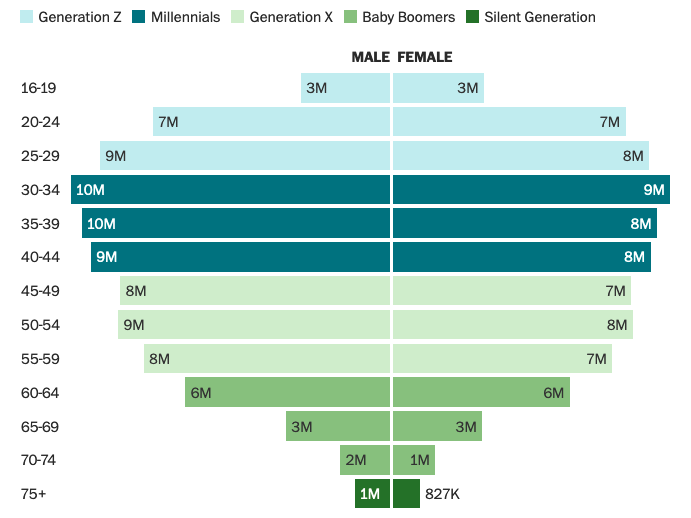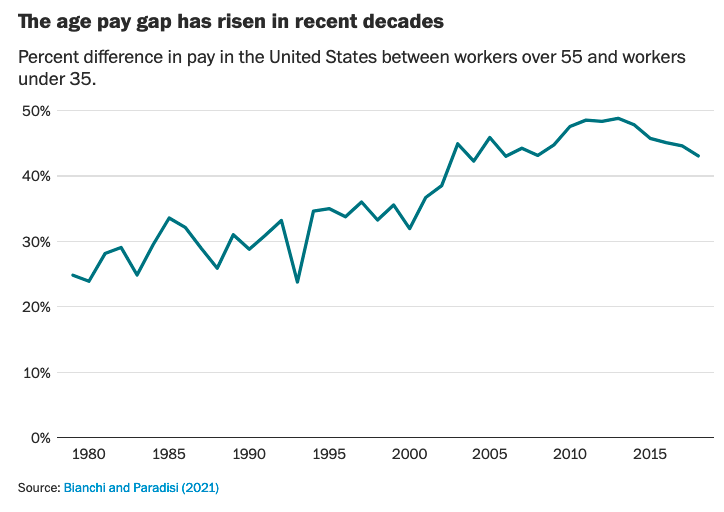This has never happened before. But now, with better healthcare creating a generation of healthy and restless senior citizens, combined with rising costs (of everything), more and more sexagenarians, septuagenarians, and even some octogenarians are clinging to their jobs. Whether they are working because they’re bored, lonely, or can’t afford to quit, they are inadvertently creating a bottle-neck, slowing advancement for the generations below them, especially Millennials (28-43) and Generation X (44-59) years old, respectively, as of 2024.
As explained in a Washington Post article, although there are benefits, including institutional knowledge and experience realized from older workers, it creates a problem for ambitious and impatient younger workers. According to Gabriele Guaitoli and Roberto Pancrazi, this demographic traffic jam impairs societal cohesion when it impacts the younger workers.
Total employed population by age group

Generation boundaries are not exact due to the Bureau of Labor Statistics' use of four-year age groupings. - Source: Bureau of Labor Statistics
For the vast majority of American workers, as well as many in other countries, their retirement plan was simply death. However, beginning in the 20th century, the creation of the middle-class, and the passage of social security, for the first time, employers started to leave the workforce with, hopefully, many years before them.
THE RISE AND FALL OF THE MIDDLE-CLASS
However, the economic health of the American middle-class started to decline in the 1990s which reversed this trend. Doubt regarding the viability of social security resulted in the retirement age begin raised to 67. Additionally, many companies discontinued their pension plans. As a result, some workers were forced to stay in their jobs longer.
Again, as reported in the same Washington Post article, "In 1990, about 10 percent of the labor force was made up of workers over 55. Now, this share is about 23 percent, and it is expected to stay around there over the next decade.
GENERATIONAL GRIDLOCK AND THE INCOME GAP
One clear sign of the shift in the workforce population is the growing income gap between younger and older workers. Economists Nicola Bianchi and Matteo Paradisi have found that neither income inequality nor changes in types of jobs is to blame. Instead, it has to do almost entirely with generational gridlock.
As older workers stay in their jobs longer, younger people start off in comparatively lower-paying positions and move up more slowly. They often have to wait decades for promotions. In academia, for instance, young professionals now spend years in fellowships and postdoctoral programs waiting for professor jobs to open.
While it’s expected that older workers earn more, given their experience, the age gap in pay has widened significantly since 2000. The United States has the highest degree of age inequality, but every rich country has experienced the phenomenon. (Poorer countries, whose populations tend to be younger, have seen inter-generational inequality decrease.)"
The age pay gap has risen in recent decades

A NEW SOURCE OF STRESS
As they face advancement gridlock, the younger employees see their best earning years dwindle as they wait longer for advancement. Their middle-class dreams of home ownership, especially in the current hyper-inflated housing market, and children are out of their grasp.
Employers, having little choice but to keep their younger employees 'on the bench', find that by the time the opportunity arises, they will have less experience than their predecessors did managing people. And, since they moved into the management positions later, they are going to want to stay there longer, which just recycles and exacerbates the problem.
WHAT CAN BE DONE?
Obviously, no one wants to force older workers out of their jobs. The key is to find a way to retain your older workers while nurturing the younger ones.
As a nation, we need to continue to encourage entrepreneurship and startups. It may be a racial idea for some companies, but any business that is looking to expand grow may want to examine how they can invest in new ventures, and use those young hot-shots with the energy and ideas and put them to work growing the company.
If this isn't possible, companies can still encourage their younger employees by giving them more responsibilities, and at the time, perhaps lightening the load for their older employees. This will create more tiers for the younger employees to advance, and providing the transitioning the older employees into mentorship and training roles.
HOW CAN ASN HELP?
Our professional recruiters are ready to provide guidance on how to create more advancement tiers, as well as how to transition older staff into mentorship and training roles. If you would like talk more about how to maximize all your employee generations, we would love to talk. Just give us a call.